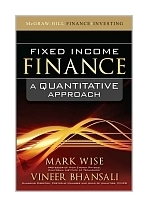The fundamentals of finance for advanced mathematical minds
Written by authors at the top of their respective fields, Fixed Income Finance
is a thorough introduction to the concepts, formulas, methodologies, and applications that
are critical to pursuing a career in fixed income finance and beyond. Bridging the gap
between basic introductory guides and advanced tomes, it provides financial engineers who
already have strong mathematical backgrounds and analytical skills with a hands-on,
quantitative guide to the basic concepts and tools they need to apply their knowledge in a
financial context.
Mark Wise is the John A. McCone professor of high-energy physics at the California
Institute of Technology.
Vineer Bhansali is a senior member of PIMCO’s portfolio management group.
Table of Contents
Preface vii
1 Bond Basics 1
1.1 Treasury Bonds and the Yield Curve 1
1.2 Duration and Convexity 6
1.3 Corporate Bonds and Credit Risk 8
1.4 Stocks 14
1.5 Arbitrage Opportunities 15
1.6 Derivatives 17
1.7 Mortgages 20
1.8 Municipal Bonds 28
1.9 Real Bonds 31
1.10 Convertible Bonds 33
1.11 CDOs and Tranches 33
2 The Mathematics of Financial Modeling 35
2.1 Normal Random Variables 35
2.2 The Central Limit Theorem 39
2.3 The Probability Distribution for Corporate Bond Returns 41
2.4 Correlated Random Variables 44
2.5 Random Walks 52
2.6 Survival Probabilities 59
2.7 Lognormal Variables 63
2.8 Mean-Reverting Random Walks 63
2.9 Correlated Random Walks 65
2.10 Simulation 67
2.11 Appendix 1: Gaussian Integrals 72
2.12 Appendix 2: Dirac Delta Function 74
3 Structural Models 77
3.1 Risk-Neutral Pricing of European Stock Options 77
3.2 Arbitrage Argument for the Pricing of Stock Options 83
3.3 A Structural Model Relating Equity and Debt 91
3.4 Risk-Neutral Default Probabilities 103
3.5 The Risk Premium 108
3.6 Including Dividends 110
4 Bond Portfolio Management 115
4.1 Investor Preferences and Utility Functions 115
4.2 Mean-Variance Portfolio Allocation 120
4.3 Beyond Mean-Variance Portfolio Allocation 121
4.4 Three Exactly Solvable Portfolio Allocation Problems 126
4.5 Portfolio Allocation to a CDO 136
4.6 Portfolio Allocation with Many Risky Assets 142
4.7 The Efficient Frontier 145
4.8 Value at Risk 150
4.9 Fixed-Income Risk Factors and Hedging 156
5 Term Structure Models 163
5.1 The Yield Curve 163
5.2 One- and Two-Factor Vasicek Models for the Yield Curve 165
5.3 Spot Yield Volatility175
5.4 The Taylor Rule 176
5.5 A Macroeconomic Two-Factor Model 182
5.6 Relationship between the Macroeconomic and Vasicek Models 184
5.7 Another Two-Factor Model 188
5.8 Models with Explicit Time Dependence 196
6 Derivatives of Bonds 199
6.1 Eurodollar Futures Rates and Volatilities 199
6.2 Future and Forward Contracts 201
6.3 European Options on a Zero Coupon Bond 203
6.4 Interest-Rate Swaps 208
6.5 Interest-Rate Caps 210
7 Trees 213
7.1 Basics 213
7.2 Binomial Trees and Stock Options 218
7.3 The Black-Derman-Toy Model for Interest Rates 223
7.4 A Heath-Jarrow-Morton Model on a Recursive Tree 233
7.5 Appendix: Discussion of HJM Code 239
Index 243
256 pages, Hardcover
Księgarnia nie działa. Nie odpowiadamy na pytania i nie realizujemy zamówien. Do odwolania !.


